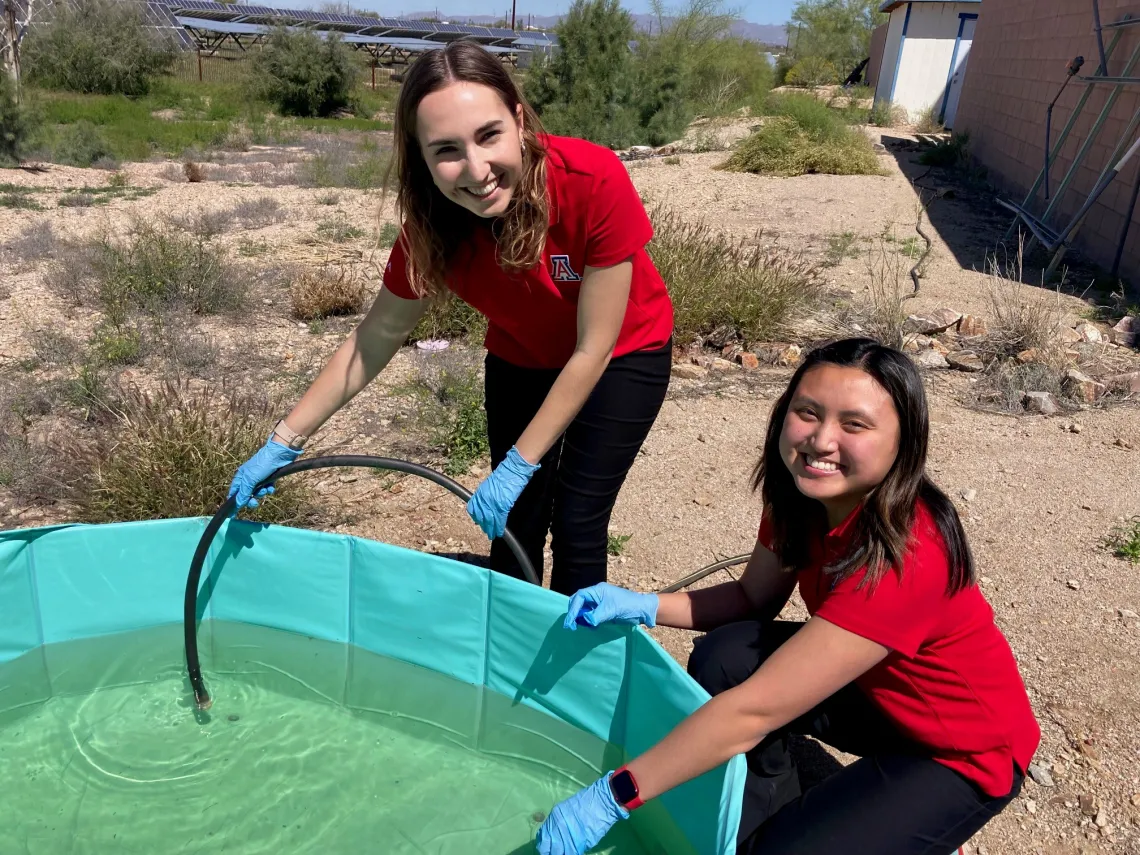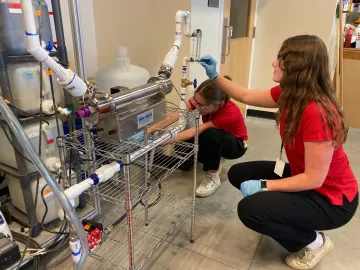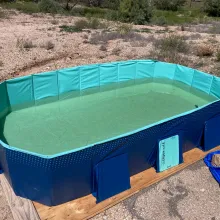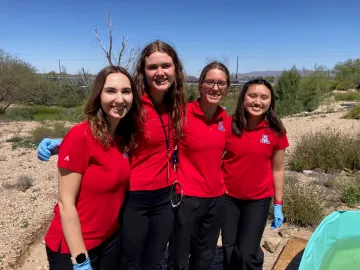UArizona students study trace organic compounds in water

Ellie Mouer (left) and Avery Royer filling the study's pool at WEST Center
Sarah Prasek
Wastewater is currently treated to a high standard of purity in most jurisdictions across the United States. However, much of the effluent produced by advanced systems still contains low concentrations of trace organic compounds (TOrCs). These compounds are the chemical byproducts of disposed pharmaceuticals, and often display estrogenic activity. Given the chemicals’ potential to be harmful to both human and aquatic health, the removal of TOrCs from effluent has become a concern.
Building on findings that TOrCs break down (attenuate) into less harmful byproducts when exposed to solar/UV light, four students at the University of Arizona designed a research study to further investigate the use of solar light to improve water quality. The students, working at WEST Center, are running experiments to measure the reduction of trace organic compounds (TOrCs) in water as a function of exposure time to solar light. The experimental design includes two sources of solar light (treatments): a UV reactor and direct sunlight.
Experimental Design
- UV Reactor

Molly Cragin (left) and Hannah McCollum with the UV Reactor at WEST Center
One test being conducted in the students’ project utilizes a UV Reactor. To measure TOrC degradation in water using this device, Ultrafiltration (UF) filtrate/water is connected to the UV reactor set-up and flow rate adjusted from 0.2 to 2.0 liters/minute. This approach allows the researchers to adjust the residence (retention) time of each run’s water in the reactor. Water samples are taken at the beginning of the trial and after each flow rate trial to evaluate the amount of degradation of the various TOrCs vis-à-vis UV exposure time.
- Direct Solar Exposure
Previous studies on water in the Santa Cruz River have shown degradation of organic compounds in river water, assumably due to natural sunlight exposure. However, these studies are not controlled (e.g., variables such as evaporation, leeching, and other natural processes are active). Likewise, laboratory studies have shown that solar exposure degrades TOrCs, but these experiments have been limited due to their small size. The study at WEST Center seeks to overcome these limitations by being both controlled and mid-scale.

Experimental retention basin
In this part of the WEST Center experiment, a small pool acts as a mock retention basin. UF filtrate is filled to various depths, and this water is exposed to solar light during optimal sunlight hours (between 10am and 2pm). For each trial, a water sample is collected at the beginning of the run (10am) on Day 1, and again at 2pm the same day before the pool is covered and light treatment ended. On Day 2, water samples are again collected at 10am and 2pm. The results of this experiment will help inform the best residence times and depths needed for a potential scaled-up design.
- Sample Analysis
Samples taken during both experimental treatments are analyzed for 23 organic compounds at a UArizona laboratory using liquid chromatography-mass spectrometry (LC-MS). Twelve (12) compounds of interest have been present and detectable 50% of the time. The degradation of these compounds is measured for each trial.
Project Outcomes
The goal of the study is to generate TOrC concentration vs exposure time data for each light treatment. Data can then be used to inform water treatment decision-making. Specifically, the project seeks to:
- better describe how residence time in a UV reactor affects TOrC concentrations in water. Currently, many water and wastewater treatment facilities use UV for disinfection. The results of this study, and/or similar studies, will allow researchers to make recommendations to utilities regarding how much additional time water should undergo UV exposure to improve TOrC removal.
- compare two solar light treatments. Studying both treatments allows for a comparison of the effectiveness of a UV reactor vs direct solar exposure to remove trace organic compounds (TOrCs). UV reactors are known to be consistent and controllable. However, sunlight exposure has its own advantages and may be an appropriate choice depending on conditions. For example, direct solar light is cheaper and requires minimal technology; its use could be deployed in more remote/rural communities; and the approach allows for treatment of larger quantities of water with little or no external energy input.
Senior Design Project Team

Senior Design Project team (left to right): Ellie Mouer, Hannah McCollum, Molly Cragin, and Avery Royer
The experiments exploring solar light impacts on TOrC concentrations are being undertaken at WEST Center as part of a Senior Design Project. The Senior Design Project team consists of four undergraduate students, all majoring in Chemical Engineering. These members – Hannah McCollum, Molly Cragin, Ellie Mouer, and Avery Royer – will graduate from the University of Arizona in Spring 2024, and each have new challenges ahead. Plans include jobs with TSMC (Ellie Mouer) and Intel (Avery Royer), while two team members will continue their studies. Hannah McCollum will pursue a PhD in Chemical Engineering, while Molly Cragin will pursue a master’s degree in Materials Science at the University of Arizona. WEST Center wishes them all the best!
The students would like to thank their advisor Dr. Eduardo Saez for guidance and project funding, and graduate research assistant, Hercilio Zimila, for meaningful advice and support.

